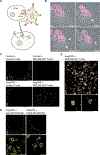CAR T cells produced in vivo to treat cardiac injury
- PMID: 34990237
- PMCID: PMC9983611
- DOI: 10.1126/science.abm0594
CAR T cells produced in vivo to treat cardiac injury
Abstract
Fibrosis affects millions of people with cardiac disease. We developed a therapeutic approach to generate transient antifibrotic chimeric antigen receptor (CAR) T cells in vivo by delivering modified messenger RNA (mRNA) in T cell–targeted lipid nanoparticles (LNPs). The efficacy of these in vivo–reprogrammed CAR T cells was evaluated by injecting CD5-targeted LNPs into a mouse model of heart failure. Efficient delivery of modified mRNA encoding the CAR to T lymphocytes was observed, which produced transient, effective CAR T cells in vivo. Antifibrotic CAR T cells exhibited trogocytosis and retained the target antigen as they accumulated in the spleen. Treatment with modified mRNA-targeted LNPs reduced fibrosis and restored cardiac function after injury. In vivo generation of CAR T cells may hold promise as a therapeutic platform to treat various diseases.
Conflict of interest statement
Figures




Comment in
-
T cells to fix a broken heart.Science. 2022 Jan 7;375(6576):23-24. doi: 10.1126/science.abn0851. Epub 2022 Jan 6. Science. 2022. PMID: 34990255
-
Fighting fibrosis with transient CAR T cells.Nat Rev Genet. 2022 Mar;23(3):136. doi: 10.1038/s41576-022-00450-3. Nat Rev Genet. 2022. PMID: 35064237 No abstract available.
-
Last-resort cancer therapy holds back disease for more than a decade.Nature. 2022 Feb;602(7896):196. doi: 10.1038/d41586-022-00241-0. Nature. 2022. PMID: 35110708 No abstract available.
-
Repairing cardiac injury with transient CAR-T cells.Nat Rev Drug Discov. 2022 Mar;21(3):179. doi: 10.1038/d41573-022-00024-2. Nat Rev Drug Discov. 2022. PMID: 35121822 No abstract available.
-
T cell immunotherapy for cardiac fibrosis: mRNA starts the CAR.Cell Stem Cell. 2022 Mar 3;29(3):352-354. doi: 10.1016/j.stem.2022.02.002. Cell Stem Cell. 2022. PMID: 35245466
-
The era of in vivo T cell engineering.Med. 2022 Feb 11;3(2):85-86. doi: 10.1016/j.medj.2022.01.012. Med. 2022. PMID: 35590210
References
-
- Schafer S, Viswanathan S, Widjaja AA, Lim W-W, Moreno-Moral A, DeLaughter DM, Ng B, Patone G, Chow K, Khin E, Tan J, Chothani SP, Ye L, Rackham OJL, Ko NSJ, Sahib NE, Pua CJ, Zhen NTG, Xie C, Wang M, Maatz H, Lim S, Saar K, Blachut S, Petretto E, Schmidt S, Putoczki T, Guimarães-Camboa N, Wakimoto H, van Heesch S, Sigmundsson K, Lim SL, Soon JL, Chao VTT, Chua YL, Tan TE, Evans SM, Loh YJ, Jamal MH, Ong KK, Chua KC, Ong B, Chakaramakkil MJ, Seidman JG, Seidman CE, Hubner N, Sin KYK, Cook SA, IL-11 is a crucial determinant of cardiovascular fibrosis. Nature 552, 110–115 (2017). - PMC - PubMed
-
- Moore-Morris T, Guimarães-Camboa N, Banerjee I, Zambon AC, Kisseleva T, Velayoudon A, Stallcup WB, Gu Y, Dalton ND, Cedenilla M, Gomez-Amaro R, Zhou B, Brenner DA, Peterson KL, Chen J, Evans SM, Resident fibroblast lineages mediate pressure overload–induced cardiac fibrosis. J Clin Invest 124, 2921–2934 (2014). - PMC - PubMed
-
- Yokota T, McCourt J, Ma F, Ren S, Li S, Kim TH, Kurmangaliyev YZ, Nasiri R, Ahadian S, Nguyen T, Tan XHM, Zhou Y, Wu R, Rodriguez A, Cohn W, Wang Y, Whitelegge J, Ryazantsev S, Khademhosseini A, Teitell MA, Chiou PY, Birk DE, Rowat AC, Crosbie RH, Pellegrini M, Seldin M, Lusis AJ, Deb A, Type V Collagen in Scar Tissue Regulates the Size of Scar after Heart Injury. Cell 182, 545–562.e23 (2020). - PMC - PubMed
Publication types
MeSH terms
Substances
Grants and funding
LinkOut - more resources
Full Text Sources
Other Literature Sources
Medical

